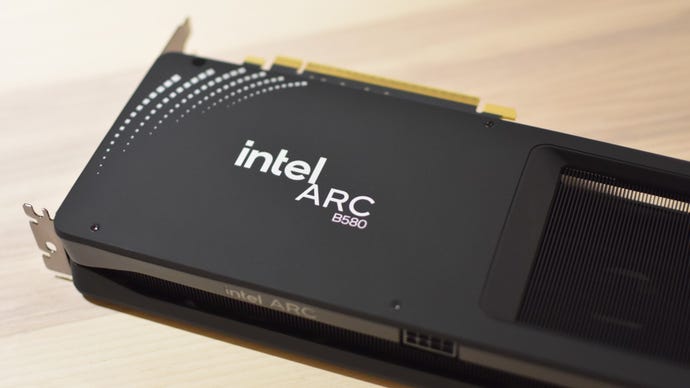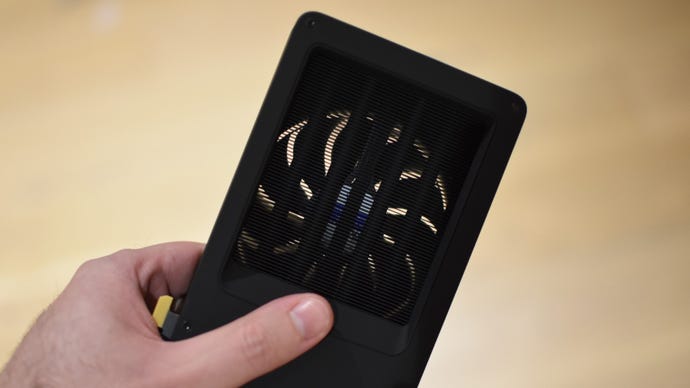Intel Arc B580 review: Late to the party, still welcome

Although not stated publicly, Intel’s new Battlemage GPU is being promoted as what the Alchemist generation should be. These eventually grew into their PCIe shoes, but only after months of dial-up driver updates – and the flagship B580 promises Nvidia’s best gaming performance from the get-go. Even at this stage in the current graphics card era (the GeForce RTX 5090 and RTX 5080 will likely be revealed at CES 2025 tonight), the proposition remains attractive.
Obviously it helps that the B580 doesn’t compete with the RTX 5090 or 5080, which undoubtedly cost the same amount of Fabergé eggs required to make an unpleasantly sharp wedding cake. Instead, the B580 is more of a 1080p RTX 4060 competitor, although Intel hints that it’s a 1440p machine. In the UK, even with Nvidia’s GPUs, the pricing range is more or less dead, with the cheapest starting at £270, while Intel’s own limited edition (in testing) costs £300. It’s even cheaper in the US, with the limited edition costing just $260, while most RTX 4060 models cost around $300.
Subtracting $40 also buys you just 4GB more VRAM than the 4060, and the B580 comes with 12GB GDDR6. It still requires a Resizeable BAR to function properly, but the Battlemage architecture has also tweaked its ray tracing core to address several of Alchemist’s weaknesses, no longer looking at DirectX 9 games with such disgust and horror. This all sounds lovely – God knows the world could use cheaper GPUs, but something like AMD’s Radeon 7600 is pointless.
Intel Arc B580 review: 1440p benchmarks
However, in actual game operation, getting the most out of the Arc B580 is not as simple as slapping the ReBAR on. First, at Intel’s preferred resolution of 2560×1440, its performance was only slightly average when paired with the Core i5-11600K on the RPS test bench. Aside from smaller single-digit framerate advantages in Metro Exodus and F1 2022, its performance is nearly identical to the RTX 4060 from nearly two years ago, even with all that extra memory.
The truth is, I’ve been wanting to update our GPU benchmarking process for years, as most of these games have either been superseded by sequels or are as old as the i5-11600K itself. So, I decided not to delay and try newer systems, newer games, and a Core i9-13900K based PC. Maybe it’s not a mass-market CPU, but it should be less prone to bottlenecks than the old i5.
With this younger, faster processor, the B580 achieves a sweep victory over the RTX 4060 in graphics performance:
Look at it, in Shadow of the Tomb Raider the shooting speed went from 3 fps behind (with different anti-aliasing, of course) to 12 fps ahead. In Metro Exodus, the RTX 4060 didn’t benefit from the CPU upgrade at all, but the Arc B580 managed another 5 fps.
Unlike the Radeon 7600 and most AMD GPUs, the B580 can also compete with Nvidia in ray tracing. Running Cyberpunk 2077 on an upgraded rig, with Psycho-level RT effects and maximum quality upgrades, the Arc B580 averaged 39 fps using XeSS, which even the RTX 4060 using DLSS couldn’t achieve. . With Ultra-Quality Ray Tracing turned on in Metro Exodus, the Arc B850 also held the lead, scoring 52 fps compared to the RTX 4060’s 43 fps. And that doesn’t help with any upgrades at all.
Intel Arc B580 review: 1080p benchmarks
I’m still not sure if the Arc B580 is the 1440p bargain Intel says it is – clearly capable At this resolution, but in newer games it can only achieve 60fps, and for an extra £70 or so you can get the faster RTX 4060 Ti. At 1080p, on the other hand, everything is smooth, even though the RTX 4060 is generally faster on older test rigs.
With the Core i9-13900K, though, Battlemage pulled off another win, taking multiple double-digit leads with the RTX 4060 and falling just short in Assassin’s Creed Phantoms.
Likewise, in the ray-traced Cyberpunk 2077 test, there wasn’t much daylight between the two – the Arc B580 hit 58 fps, the RTX 4060 hit 59 fps – and with Ultra RT enabled in Metro Exodus , the Intel GPU is still faster, averaging 149 fps. Since F1 2024’s Ultra preset is also preset with ray tracing enabled, this also shows that the Arc B580 can withstand the additional strain without deforming.
There’s a lot of good stuff here, even if you’re not actively buying parts and just want to see something from the one-party state that is a modern graphics card. Nvidia is no longer the only manufacturer that does ray tracing well, nor can it uncontroversially claim to be able to make the fastest sub-£300 card of the current generation – on a native rez, anyway. Even the RTX 4060’s excellent power efficiency doesn’t go unchallenged: the Arc B580 seems to be the loser here, with its 190W power rating and 600W PSU requirement dwarfing the 4060’s 115W power rating and 550W requirement. But in fact, the maximum power consumption I recorded on the B580 was only 118W, which exceeded the 126W I saw on the 4060. Its Nvidia rivals have a temperature range of around 69-74°c.
Like I said, good stuff. However, the Arc B580’s reliance on CPU power also means that personal opinion applies more than the usual bar chart comparisons. Does the card take advantage of newer CPU technology well enough to maintain the performance advantage, or is it actually coupled with the latest, most expensive chip, making it unbootable for people with older computers?

Honestly, I think it’s a little bit of both. Keep in mind that cheaper graphics cards tend to find their way naturally into aging desktops, so tying the Arc B580’s best features so closely to an upgrade to another relatively expensive component is definitely not ideal. At the same time, this is not a rigid requirement for the latest Core i9. My previous CPU tests showed that the i9-13900K is actually not much faster than the midrange Core i5-13600K, which itself is only slightly faster than the Core i5-12600K, which is now in its third generation. In other words, the Arc B580 may fail on older PC setups, but anyone who’s updated within the past few years will probably be fine.
It’s not just ray tracing that Intel is catching up to. It’s currently only released and functional in F1 24, but XeSS 2, the latest version of its DLSS-like upgrade technology, gives the Arc B580 another tool to boost frame rates. So far, XeSS 2 looks to be on par with DLSS in overall visual quality – quite an achievement considering AMD FSR has been trying and failing for years – and its new frame generation component is replicating DLSS 3 also does an impressive job promoting the smoothness of its AI generation. Even beat it. With XeSS 2 enabled, 45 fps at 1440p becomes 80 fps, while at 1080p it jumps from 56 fps to 102 fps, which in both cases is higher than what the RTX 4060 produced under DLSS 3. 57 fps and 77 fps.
AMD is again trying a very similar approach with FSR 3, but XeSS 2 seems to produce better-looking results without adding too much input lag. I’d love to try XeSS 2 in something more exciting than gamepad-controlled racing, but what F1 24 has shown so far is encouraging.

It is worth noting that DLSS 3 has achieved a huge lead in game support and is currently available in more than 100 games, with dozens more games to come. XeSS 2 will have a hard time catching up, which means DLSS 3 is still a more valuable feature, and that value will be transferred to GPUs that support it, including the RTX 4060.
Therefore, the Arc B580 doesn’t completely make the RTX 4060 obsolete. Nvidia will likely keep priority on the inevitable RTX 5060. We, it won’t lose as much as the old wafers either.
Instead, for a new build (or a PC that’s updated beyond the GPU), the Arc B580 is a legitimate choice. In fact, if you can live without the more widely used framework generation style, this is arguably the better one. In addition to fixing Alchemist’s ray tracing weaknesses and stabilizing everything overall (I didn’t experience the same crashes as the Arc A750), the Battlemage architecture also results in a pleasantly vibrant, affordable GPU that’s more than adequate for smooth 1080p. It doesn’t even require twenty driver updates to achieve this.
This review is based on a retail unit provided by the manufacturer.



